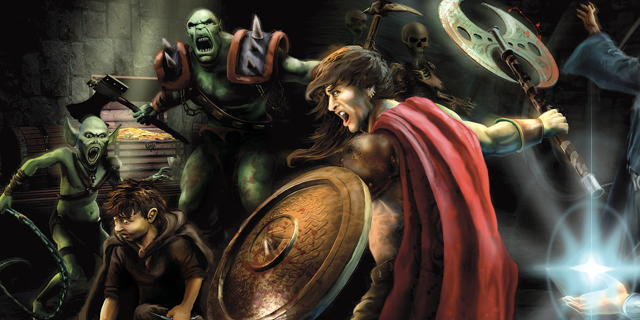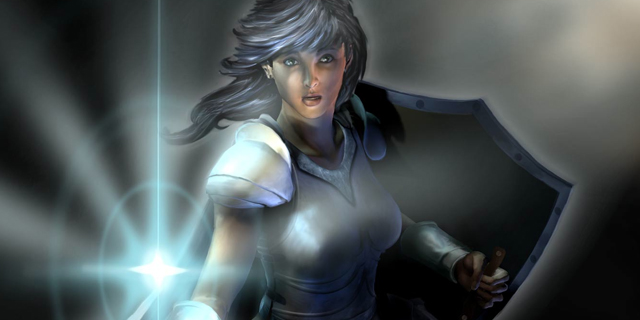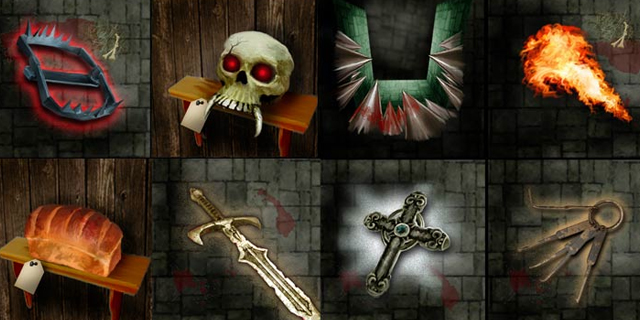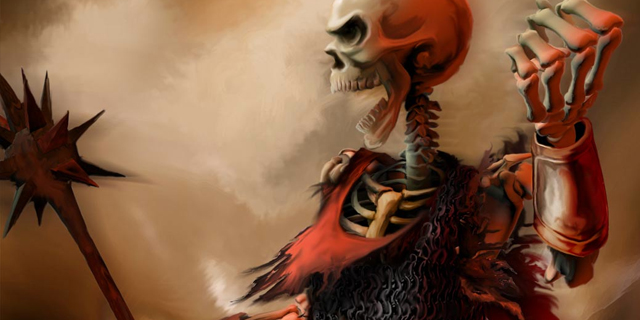
Dungeons & Dragons casts a large shadow over the modern gaming hobby, both as a gateway to paths beyond the usual Parker Brothers or Milton Bradley fare and as a high fantasy experience delivery vehicle. The “dungeon crawl” genre ranges from Munchkin-style parody to Descent: Journeys in the Dark epic missions, but few if any can be played in under an hour until now. Billed as “your lunch break dungeon crawl” on its Kickstarter page, Dungeon Heroes (from Michael Coe’s Gamelyn Games) pits one player as the dungeon versus another as the traditional group of four heroes (warrior, cleric, rogue, and wizard) searching the dungeon for treasure.
The dungeon itself is a six-by-six grid, with four additional spaces on each player’s side for the treasure vault and heroes’ starting spaces. The hero player places figures in the starting spaces and takes the corresponding hero boards and color-coded health dice. On the other side of the board, the dungeon player sets up a draw pile by placing the ten monster tiles, ten trap tiles, three treasure tiles and a random selection of 13 of the 23 other tiles (making a total pile of 36); the remaining ten tiles are set aside unseen by either player.
Play begins with the dungeon player, who starts off in a passive role. Until all 36 tiles have been placed, each turn the dungeon player will randomly draw four at a time and place them face-down on unoccupied spaces in the grid. Once all the tiles have been drawn and placed, the dungeon becomes aggressive and the player gets four actions with which to either reveal a tile or move and attack with a revealed monster (with a limit of one action per monster). The dungeon player cannot look at tiles once placed, so memory of which tiles were placed in which location is a valuable skill to cultivate. The dungeon player’s goal is to eliminate all four of the heroes.

After each of the dungeon player’s turns, the hero player gets four actions. Each action can be spent to either move a hero or to use a hero’s special ability, although no individual hero may take more than two actions each turn. The Warrior automatically kills any monster he encounters, while the Rogue disarms traps in a similar fashion. Any other hero moving on to one of these tiles (including the Warrior on a trap or the Rogue on a monster) suffers damage indicated on the tile, with monster tiles remaining on the board but trap tiles being removed once triggered. The Cleric can restore two health to herself or an adjacent hero, and the Wizard has the ability to reveal unoccupied dungeon tiles. The Wizard’s ability is particularly potent while the dungeon player is passive, as it will allow the heroes to avoid all manner of nasty surprises. The hero player’s objective is to find three of the four treasures hidden in the dungeon, one of which can be obtained by moving a hero to any one of the four vault spaces on the other side of the board.
In addition to traps, monsters and treasure, the heroes might discover artifacts that can allow them a one-time replication of another hero’s special ability or, if they are lucky enough to find the holy grail, revive a fallen comrade. These items can be transferred to an adjacent hero for one action, if necessary. Of course, they might also encounter a portal that will fling them back to their starting point, shifting floors that will move them into further danger or even poison clouds that will kill them instantly. The mix of these tiles present in the dungeon player’s draw pile will play a large role in determining how difficult the game will be for the heroes.

Besides management of the heroes’ skills and actions, the hero player’s other greatest asset is deductive reasoning. Of the tiles in the mix, 23 are known quantities, and as tiles are revealed or eliminated, the identities of those yet unrevealed can be determined. Of course, a lucky hero player (or unlucky dungeon player) can end the game before the dungeon even becomes aggressive, but the reverse is also true should the hero player be careless with exploring unrevealed tiles. Losing the Warrior or the Rogue will be a huge setback to the heroes, as their skills are key to survival. This is especially true when the dungeon becomes aggressive and the monsters start actively stalking the heroes.
Speaking of those monsters, the Kickstarter raised enough funds for some truly exceptional wooden figures to be included with the game. These aren’t your garden-variety meeples, and they really make the game stand out. Also funded were two mini-expansions: The Dragon and the Damsel and Lords of the Undead. As you might guess, The Dragon and the Damsel introduces a new monster and a new hero, although the Damsel must be found first. It also adds two additional tiles to the draw pile, although the total number of tiles in the pile can never exceed 36, so fewer of the random tiles from the base set will be included.
Lords of the Undead brings two new monsters to the mix (again, reducing the random tiles to compensate): the monster-reviving Necromancer and the hero-possessing White Lady. These monsters, as well as the horrifying Dragon, are unique in that they are aggressive as soon as they are revealed. Acting with these monsters come at the cost of placing a tile, which will delay the onset of the actual aggressive phase. Fortunately for the heroes, this second expansion also introduces a market. As an action, a hero may turn in a listed amount of experience points (damage values of slain monsters/disarmed traps) to purchase one of four powerful artifacts.

The greatest strength of Dungeon Heroes is the fact that it can be played in under half an hour, especially since teaching it and setting up will take less than five minutes. As a game limited to head-to-head play, that is ideal. If you enjoy D&D-style games without having the time to devote to a full RPG session, Dungeon Heroes can serve as a quick substitute whenever you need it. The base game will cost $30, with the two-in-one expansion available for an additional $15. They should both be widely available this fall.



















